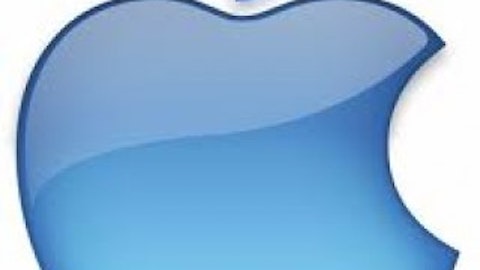Apple Inc. (NASDAQ:AAPL) continues to see flight from institutional holders. Fidelity Contrafund Fund (MUTF:FCNTX), the largest shareholder of Apple, cut its position by 10% through the first two months of 2013. It now holds 10.43 million shares of Apple, a $4.41 billion position. The fund’s new number one position is Google Inc (NASDAQ:GOOG) at 5.8% of assets–Apple now accounts for 5.2% of fund assets.

The reduction in the position by Apple’s largest holder is something of a concern for other investors. First, the fund holds a lot more shares, and shares face a headwind if it plans to continue trimming the size of its position, or worse, exit the position altogether. Second, although the stock has sold off significantly and many consider it a value at current levels, apparently that list does not include its largest shareholder.
The indication here is that other stocks are more attractive right now than Apple Inc. (NASDAQ:AAPL). The momentum for Apple has yet to reverse, and trying to pick its bottom is analogous to trying to catch a falling knife. Apple, at best, may be dead money in the near-term. It is hard to find a motivating reason to own Apple right now besides the fact that it looks cheap versus returns and earnings over the coming years. It lacks obvious catalysts over the next twelve months that will drive shares higher.
Other large cap tech stocks like Google Inc (NASDAQ:GOOG), Microsoft Corporation (NASDAQ:MSFT), and Amazon.com, Inc. (NASDAQ:AMZN) have catalysts and greater potential for positive news events. Many of the catalysts for these stocks are actually related to chipping away at Apple Inc. (NASDAQ:AAPL)’s position in its core markets. Specifically, Microsoft and Google are gaining share in the smartphone market. Microsoft Corporation (NASDAQ:MSFT)’s Window’s Phone is pushing into the market via the Nokia Lumia. Google’s operating system is already ahead of Apple’s iOS in global market share, and it continues to make gains, particularly with its partners HTC and Samsung. According to comScore, Google Inc (NASDAQ:GOOG) had 51.7% of the OS market, Apple had 38.9%, Blackberry had 5.4%, and Microsoft had 3.4%. Microsoft Corporation (NASDAQ:MSFT)’s OS isn’t a huge threat at the moment, though Microsoft has $68 billion in cash which it could deploy into mobile R&D if it wanted to. Amazon.com, Inc. (NASDAQ:AMZN) is pushing up against iTunes and gaining share of the tablet market along with Google and Microsoft.
As a reminder, both Google Inc (NASDAQ:GOOG) and Microsoft Corporation (NASDAQ:MSFT) have tablets, and Google has used this, along with its mobile OS, to take share from iTunes as the leading provider of apps to the mobile and tablet market. Google doesn’t give out its sales figures for the Nexus 10 (released in November) at the moment, but industry experts are estimating sales of about 680,000 units. Google’s sales of the Nexus 7 are estimated to be 10x that amount. So, as an investor, do I want to hold the stock that is gaining share or the one that may be losing it? Also, the impact on margins and when the share loss stops is anything but certain.
The bull argument is that Apple Inc. (NASDAQ:AAPL) should recover, and current levels have priced in too little growth. The shares will appreciate since its valuation is attractive, based on consensus estimates, sometime over the next 1-36 months. However, this case still means a fund manager could miss out on stocks that may outperform this year for one that may outperform next year or the year after. This translates to lower bonuses, potential outflow of funds under management, and if you do this a few years in a row waiting for that big payoff, you may be job hunting.
Conclusion
For investors with patience and a longer investment horizon that are not trying to outperform on a twelve month but lifetime basis, this can create an opportunity. An investor should look for the point where the shares of Apple Inc. (NASDAQ:AAPL) appear to have stabilized, but this is harder than it sounds. Often it makes sense to miss the first 10%-15% of a stock bouncing back to be sure you are not catching that falling knife. Buying Apple does require the belief that it may lose some share, but those losses will stabilize. This will result in 2014-2015 earnings estimates holding close to their current levels and the stock appreciating.
The article Apple Investors Need Patience originally appeared on Fool.com and is written by Mike Thiessen.
Copyright © 1995 – 2013 The Motley Fool, LLC. All rights reserved. The Motley Fool has a disclosure policy.
